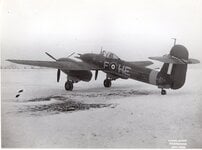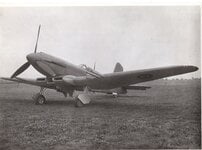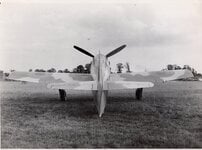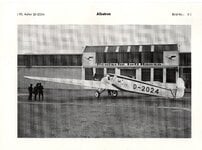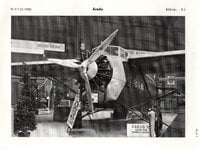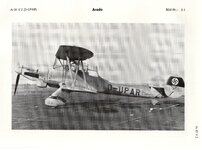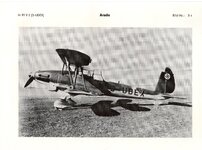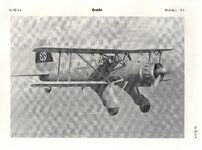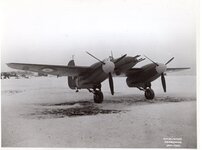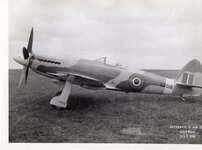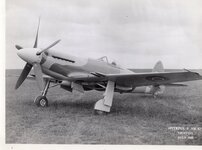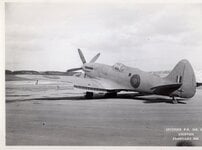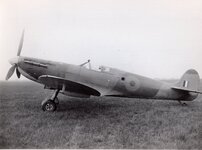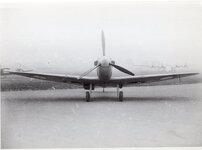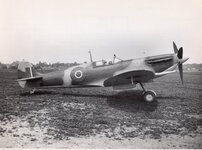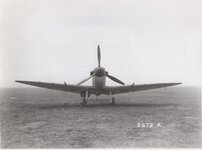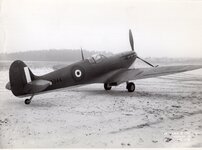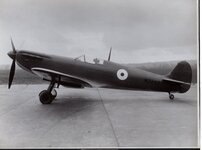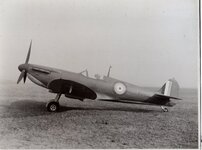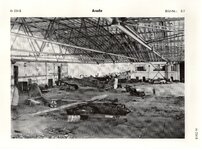So after a busy week with assignments, we are looking at post #43 and begin with Images 811 and 813 of a Halifax III. I can't identify it, but the aircraft in the background is Spitfire, ahem, Seafire III LR874, which was at Boscombe Down undergoing performance trials. Blurry image 812 is a different aircraft and '814 is different again, note the absence of the H2S dome under the rear fuselage in the aircraft in '811 and '813; in '814 is Halifax GR.III NR187. Built by English Electric, this one is clean as a whistle and looks like it's just rolled out of the factory. I can't say anything more about this airframe or the others. Note the white cowling gills on the aircraft in images '811, '812 and '813, but not '814, obvious on a night bomber.
Image 815 is a Short Stirling V transport, it is possible this is the prototype of that variant, LJ530. The prototype was converted on the production line at Rochester, but the production Mk.Vs were built by the Short factory in Belfast, down the road from the Harland and Wolff slipway where the Titanic was built. The Mk.V was designed in support of the Tiger Force, but when that went nowhere the production aircraft were used as general transports with RAF Transport Command and some were converted passenger aircraft, carrying 29 people in their capacious fuselage.
Image 817 and '818 ('816 has flown away?) show the second Stirling Mk.II prototype N3711, this aircraft was powered by Wright R2600 Cyclone engines and was at Boscombe Down in May 1942 with the Intensive Flying Flight, trials revealing that it was unsuitable for operation because of poor ceiling and manual mixture control, excessive noise and vibration plaguing the aircraft, and the engines overheated, which necessitated keeping the cowling gills open, which reduced their temperature but this reduced the aircraft's speed in the cruise.
Image 819 an often produced image of the third prototype Blackburn Roc L3059 being evaluated with floats. The photo was taken at the MA&AEE facility at Helensburgh, Scotland in November 1939. By the end of the next month it had been destroyed in a crash (I guess you were right, Azul!). Prior to this it was found that it suffered directional instability and didn't like being turned at low altitude, until an extra fin was added under the tail, not pictured here. This was not good for a fighter and altogether the floatplane Roc, of which only a few were converted was a bit of a disaster, with one that had crashed during trials, a second having as short a career as this one, being scrapped in March 1940 and the first, relegated to becoming an instructional airframe. Probably the best thing for them. Pilots in the FAA catapult fighter squadrons probably breathed a sigh of relief on hearing the type wasn't entering service...
Image 820 shows the prototype Roc, L3057, which was the first Roc converted as a floatplane, the work done at Blackburn's factory at Dumbarton, which was only a few miles along the Clyde from Helensburgh, which means the ferry pilots didn't really have time to realise the aircraft they were sending for evaluation was just rubbish and they should exit the aircraft mid ferry flight and save themselves... This aircraft underwent trials at Boscombe Down before the war in 1939, to evaluate the Boulton Paul turret installation and for performance trials, which not unsurprisingly revealed that the Roc was quite slow and its rate-of-climb was marginally improved by fitting a Skua's propeller, seen fitted in this image, also, an Armstrong Siddeley Tiger engine snaffled from a Whitley bomber was fitted to the second prototype (not this one), which boosted its maximum speed from 224 mph to 227 mph!
Images 821 through '825 (missing '822) show the prototype Daffy TT.I target tug DR863 in a rather snowy setting; note that instead of the photographer walking around the aircraft to get the standard recognition shots, they have done the opposite and moved the aircraft! This Defiant spent five weeks on the ground at Boscombe Down due to unserviceability and left in July 1942 having achieved nothing except being moved about in the snow for the photographer! When it left, it was devoid of its towing equipment. DR863 was the first of an order for 150 TT variants, which were based on the Mk.II airframe, hence the titling on the photos.
Image 826 shows Defiant II N1551 photographed in November 1940, this was the first Daffy fitted with a Merlin XX, which improved the type's performance, achieving 313 mph over the previous Merlin III engined Defiant I K8620's maximum speed of 312 mph, although Daffy I L6954 could only manage 303 mph.
Image 827 shows another Daffy TT.1, this time spouting a rather swollen air intake housing a new oil cooler; this is TT.III N3488, which was at Boscombe Down in late 1942, which was powered by a Merlin III as per the F.I variant rather than the Merlin XX of the F.II and TT.I model previously seen, which resulted in oil overheating hence the new cooler.
Image 828 shows the third prototype Beaufighter R2054 looking spotless, one of four that had arrived at Boscombe Down for trials by July 1940, but by the end of September all four had been returned to the manufacturer without a single trial having been finished owing to a large number of defects found whist the aircraft were there! Handling and stability were affected, which warranted them being returned to the manufacturer - this wasn't uncommon for prototypes being returned to the manufacturer before trials could continue because of manufacturing faults, they were, after all, built by hand and not on a production line; the Halifax prototype was the same.
Images 829 through '831 show Beaufighter NF.VI V8442, this aircraft was at Boscombe Down for engine trials, being fitted with Hercules XVI engines with engine cooling measurements being carried out. Note the Air Interception radar transmitter aerials on the leading edges and the receiver aerials the diagonal ones midway along the wing upper and lower surfaces of the right wing only, visible in image '831 and faintly in '829. In that first image, the four 20 mm Hispano cannon ports have been covered over with doped fabric patches. It's wet there, note the tyres are glistening.
And finally, a very special aeroplane, the first prototype de Havilland Mosquito E0234, its serial later changed to W4050, in its all-over yellow colour scheme, this side view emphasising its sleek lines. Arriving at Boscombe in February 1941, the aircraft had completed 8 and a half hours flying time before it was taxied over a bumpy patch of ground, which broke its fuselage at the wing, so it had surgery in the form of the second prototype's fuselage being rushed into replacing the broken one. During these trials the aircraft's excellent speeds became apparent, achieving 388 mph at 20,000 feet, which was quite quick in early 1941 for a twin engined machine, although its stalling speed was regarded as high for the time, 105 clean and 90 mph with flaps. The cockpit was considered small, but confortable. This picture was taken before the accident because after repairs that only took a few days, the engine nacelles were lengthened at their rear to protrude aft of the wing trailing edge as production Mosquitoes did. Note the trestle rash on the fuselage side and the absense of undercarriage doors, which leads me to suspect this picture was taken at Hatfield rather than Boscombe - the Tiger Moths in the background might confirm this, where it was taken by road after the major components had been built at Salisbury Hall; subsequently the following prototypes (except the second, devoid of a fuselage before completion) built at the mansion house were flown out of the grounds there to Hatfield, which included the fourth prototype W4053, which was fitted with a gun turret...
Next time, more Mossie Madness...
Image 815 is a Short Stirling V transport, it is possible this is the prototype of that variant, LJ530. The prototype was converted on the production line at Rochester, but the production Mk.Vs were built by the Short factory in Belfast, down the road from the Harland and Wolff slipway where the Titanic was built. The Mk.V was designed in support of the Tiger Force, but when that went nowhere the production aircraft were used as general transports with RAF Transport Command and some were converted passenger aircraft, carrying 29 people in their capacious fuselage.
Image 817 and '818 ('816 has flown away?) show the second Stirling Mk.II prototype N3711, this aircraft was powered by Wright R2600 Cyclone engines and was at Boscombe Down in May 1942 with the Intensive Flying Flight, trials revealing that it was unsuitable for operation because of poor ceiling and manual mixture control, excessive noise and vibration plaguing the aircraft, and the engines overheated, which necessitated keeping the cowling gills open, which reduced their temperature but this reduced the aircraft's speed in the cruise.
Image 819 an often produced image of the third prototype Blackburn Roc L3059 being evaluated with floats. The photo was taken at the MA&AEE facility at Helensburgh, Scotland in November 1939. By the end of the next month it had been destroyed in a crash (I guess you were right, Azul!). Prior to this it was found that it suffered directional instability and didn't like being turned at low altitude, until an extra fin was added under the tail, not pictured here. This was not good for a fighter and altogether the floatplane Roc, of which only a few were converted was a bit of a disaster, with one that had crashed during trials, a second having as short a career as this one, being scrapped in March 1940 and the first, relegated to becoming an instructional airframe. Probably the best thing for them. Pilots in the FAA catapult fighter squadrons probably breathed a sigh of relief on hearing the type wasn't entering service...
Image 820 shows the prototype Roc, L3057, which was the first Roc converted as a floatplane, the work done at Blackburn's factory at Dumbarton, which was only a few miles along the Clyde from Helensburgh, which means the ferry pilots didn't really have time to realise the aircraft they were sending for evaluation was just rubbish and they should exit the aircraft mid ferry flight and save themselves... This aircraft underwent trials at Boscombe Down before the war in 1939, to evaluate the Boulton Paul turret installation and for performance trials, which not unsurprisingly revealed that the Roc was quite slow and its rate-of-climb was marginally improved by fitting a Skua's propeller, seen fitted in this image, also, an Armstrong Siddeley Tiger engine snaffled from a Whitley bomber was fitted to the second prototype (not this one), which boosted its maximum speed from 224 mph to 227 mph!
Images 821 through '825 (missing '822) show the prototype Daffy TT.I target tug DR863 in a rather snowy setting; note that instead of the photographer walking around the aircraft to get the standard recognition shots, they have done the opposite and moved the aircraft! This Defiant spent five weeks on the ground at Boscombe Down due to unserviceability and left in July 1942 having achieved nothing except being moved about in the snow for the photographer! When it left, it was devoid of its towing equipment. DR863 was the first of an order for 150 TT variants, which were based on the Mk.II airframe, hence the titling on the photos.
Image 826 shows Defiant II N1551 photographed in November 1940, this was the first Daffy fitted with a Merlin XX, which improved the type's performance, achieving 313 mph over the previous Merlin III engined Defiant I K8620's maximum speed of 312 mph, although Daffy I L6954 could only manage 303 mph.
Image 827 shows another Daffy TT.1, this time spouting a rather swollen air intake housing a new oil cooler; this is TT.III N3488, which was at Boscombe Down in late 1942, which was powered by a Merlin III as per the F.I variant rather than the Merlin XX of the F.II and TT.I model previously seen, which resulted in oil overheating hence the new cooler.
Image 828 shows the third prototype Beaufighter R2054 looking spotless, one of four that had arrived at Boscombe Down for trials by July 1940, but by the end of September all four had been returned to the manufacturer without a single trial having been finished owing to a large number of defects found whist the aircraft were there! Handling and stability were affected, which warranted them being returned to the manufacturer - this wasn't uncommon for prototypes being returned to the manufacturer before trials could continue because of manufacturing faults, they were, after all, built by hand and not on a production line; the Halifax prototype was the same.
Images 829 through '831 show Beaufighter NF.VI V8442, this aircraft was at Boscombe Down for engine trials, being fitted with Hercules XVI engines with engine cooling measurements being carried out. Note the Air Interception radar transmitter aerials on the leading edges and the receiver aerials the diagonal ones midway along the wing upper and lower surfaces of the right wing only, visible in image '831 and faintly in '829. In that first image, the four 20 mm Hispano cannon ports have been covered over with doped fabric patches. It's wet there, note the tyres are glistening.
And finally, a very special aeroplane, the first prototype de Havilland Mosquito E0234, its serial later changed to W4050, in its all-over yellow colour scheme, this side view emphasising its sleek lines. Arriving at Boscombe in February 1941, the aircraft had completed 8 and a half hours flying time before it was taxied over a bumpy patch of ground, which broke its fuselage at the wing, so it had surgery in the form of the second prototype's fuselage being rushed into replacing the broken one. During these trials the aircraft's excellent speeds became apparent, achieving 388 mph at 20,000 feet, which was quite quick in early 1941 for a twin engined machine, although its stalling speed was regarded as high for the time, 105 clean and 90 mph with flaps. The cockpit was considered small, but confortable. This picture was taken before the accident because after repairs that only took a few days, the engine nacelles were lengthened at their rear to protrude aft of the wing trailing edge as production Mosquitoes did. Note the trestle rash on the fuselage side and the absense of undercarriage doors, which leads me to suspect this picture was taken at Hatfield rather than Boscombe - the Tiger Moths in the background might confirm this, where it was taken by road after the major components had been built at Salisbury Hall; subsequently the following prototypes (except the second, devoid of a fuselage before completion) built at the mansion house were flown out of the grounds there to Hatfield, which included the fourth prototype W4053, which was fitted with a gun turret...
Next time, more Mossie Madness...

